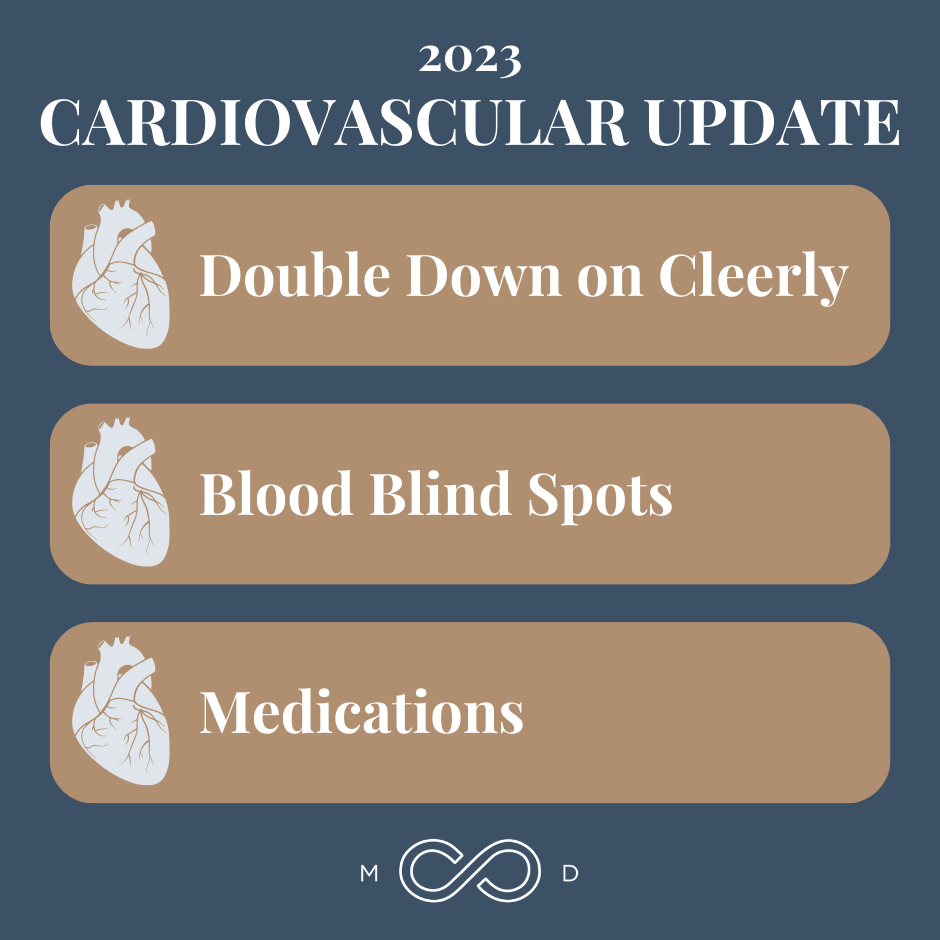Download file | Play in new window | |
As someone who’s navigating my own cardiovascular risk profile along with those of my patients, I’m excited to share with you the three cutting-edge diagnostic and therapeutic tools you need to know about in 2023 for cardiovascular risk reduction.
But first, let’s rewind: what exactly is heart disease?
Heart disease is a broad term that covers a variety of conditions, including hypertension, heart attack, stroke, and vascular disease. All these conditions are linked to the hardening of the arteries that supply blood to the heart, or the coronary arteries. This hardening process, known as atherosclerosis, is complex and multifactorial, meaning it doesn’t develop along a simple, clear path.
Atherosclerosis is one of the only diseases that’s inevitable. If you live long enough, your arteries will begin to harden. However, you can significantly delay this process AND reduce its impact on your life.
The highest risk factors for developing atherosclerosis are accelerators that speed up the atherosclerotic process, such as:
- Smoking
- Diabetes
- Obesity
- Family history of heart disease
By identifying and addressing these risk factors, you help slow the progression of disease.
Catching existing cardiovascular disease in its early stages can also make an enormous difference in your long-term outlook. When we get early eyes on the disease, we can be far more strategic in taking steps to avoid long-term negative impact.
And, happily, we have some game-changing new diagnostic tools to identify early signs.
In this post, we’re taking a high-level look at three particular areas to learn about for cardiovascular risk reduction in 2023:
- Modern diagnostic technology
- Bloodwork blind spots
- New medication approaches
1. Double Down on Cleerly
One tool that has really changed the game in this area is the use of coronary computed tomography angiography (CCTA).
The last game-changing advance we saw in cardiovascular risk assessment was the calcium score, which tells you how much hardened, stable plaque you have in your arteries. These scores were — and still are — important tools in risk assessment, but the CCTA has catapulted our ability to catch heart disease early far beyond even that benchmark.
Over the last three years, we’ve gone from intrigued to fascinated to fully evangelistic regarding this technology and its potential for helping address one of the top killers of humans on this planet. The specific technology we use in our office is a tool called Cleerly, which we’ve talked about previously.
To use Cleerly, we first take a CT scan of the coronary arteries and then upload the images to a cloud-based program that uses artificial intelligence to assess — with granular-level detail — the amount and type of plaque burden on the cardiovascular system. It’s basically a virtual heart catheterization, providing the same (or better) information, but completely non-invasive.
Cleerly changes the game because it allows us to see what’s actually going on inside the arteries. All our other diagnostic measures — like a calcium score or cholesterol level — only give us indications, or they’re too invasive to use without substantial caution, like a heart cath.
By catching plaque buildup early and determining whether it’s stable, hardened plaque or the more dangerous and unstable soft plaque, we have opportunity to take effective action. We no longer have to guess whether a change is necessary or effective. We know.
A Tale of Two Heart Scans
Jen and I both recently got our calcium scores and Cleerly scans. If you’ve read or listened to our content before, you probably know we take our cardiovascular health very seriously. Jen’s calcium score was a pristine zero; mine was a relatively mild 46 (though I was still disappointed with that number).
But all our calcium score told us was how much stable, calcified plaque was present in our arteries. We still had no idea how much unstable, soft plaque was lurking undetected.
That’s where our Cleerly results came in. Not surprisingly, Jen’s Cleerly came back fine for any significant non-calcified plaque buildup, which gives her peace of mind and tells her she doesn’t need to make any changes right now.
My Cleerly, however, surprised us and told me I need to make some changes to address my soft plaque buildup and lower my cardiovascular risk — which I wouldn’t have known based on a calcium score alone.
Cleerly provides a deeper layer of confidence in the reliability of the data you’re looking at — because even with normal blood pressure and cholesterol, plaque buildup can still be present. With reliable data, you can make more powerful decisions for your health. That’s why we recommend these scans not just for patients with known cardiovascular risk factors, but for anyone who wants to be proactive about their cardiac health.
Cleerly has unequivocally changed the game for how we, in our practice, risk stratify our members for heart disease — the number one killer of humans on the planet.
Cleerly As an Investment
Although insurance may not cover the cost, I can’t recommend CCTA strongly enough for anyone over the age of 50. It’s a powerful tool in adopting the offensive mindset we talk about so often, giving you the data you need to de-risk your future.
2. Blood Blind Spots
As a physician, I’m always looking for ways to improve the health of my patients. But sometimes, even as a self-aware and observant person, I have blind spots when it comes to my own health.
My Cleerly results redirected the trajectory of my thinking about my own health, leading me to scrutinize all the numbers I’d previously viewed as fine in my health. And I noticed some vulnerabilities — a mildly elevated blood pressure and a mildly elevated ApoB, or LDL particle number.
Neither of my readings are inherently scary, but they aren’t ideal, and they appear to be contributing to my accumulating arterial plaque.
Addressing these vulnerabilities has become a priority for me as I aim to de-risk my future and live a long and healthy life. And because that’s what I want for our members as well, this has led me to re-evaluate how I approach cardiovascular risk management with patients.
Mild Hypertension
I’m incredibly aggressive when it comes to managing metabolic factors like insulin resistance and metabolic disease. And yet, I haven’t translated that same offensive intensity to the area of blood pressure. But I now have unequivocal evidence that even mild hypertension actively introduces extra cardiovascular risk into a person’s life.
A mildly elevated blood pressure may not be scary in the short term, but it’s absolutely not at goal level. As hunters of the factors that will affect our long-term health and shorten our lifespans, we need to bring our intensity and focus to hypertension.
Now that I’ve recognized this blind spot, I’m ready to ratchet down on it for both myself and our members.
ApoB Elevation
In a metabolically pristine patient, I used to take a watchful waiting approach to trivial elevations in cholesterol particle numbers. But, as with blood pressure, I’ve realized this isn’t proactive enough.
In our practice, we routinely check ApoB (the primary protein found in LDL, or “bad” cholesterol) for our members and note where their numbers are trending. By regularly checking a patient’s ApoB particle number, we can spot concerning changes over time and respond offensively.
Trending out data, whether for cholesterol numbers or blood pressure, is crucial for monitoring cardiovascular risk. Besides exposing hidden early disease, it provides concrete data to help patients and physicians make unemotional, objective decisions to improve health.
3. Medications
Three classes of drugs are making an impact in the world of cardiovascular risk management. Here’s an overview.
Statins
You’ve probably heard of this first drug class. Statins, which are designed to lower cholesterol by suppressing your liver’s production of it, attract a lot of debate and discourse. If you’ve had an anti-statin mindset in the past, I just ask that you keep an open mind in this section.
The only reason I care about cholesterol is in relation to cardiovascular disease. So what I’m really interested in regarding statin therapy is whether it actually affects your cardiovascular disease risk and outcome.
In this, the data is clear. If you have established cardiovascular disease, or if you’ve had a cardiac incident like a mild myocardial infarction, a statin greatly improves your survival rate.
Why? Statin therapy converts unstable plaque (the soft plaque that ruptures and causes heart attacks) to stabilized plaque. So, although we’d like to reduce plaque altogether, the next best thing is to calm existing plaque by converting it into low-risk, calcified plaque.
Because of this, anyone who has evidence of non-calcified plaque accumulating in their coronaries — which a Cleerly study can show — should seriously consider statin therapy. They’re inexpensive and generally well tolerated, though if you have difficulty with one, there are many different options to try.
Questions About Statins
Four important questions surround statin therapy in the context of plaque management:
1. Can you slow down plaque formation? Yes, by lowering the amount of cholesterol you’re making, statins slow down the accumulation of LDL particles in your coronary arteries.
2. Can you change the composition of a plaque from unstable to stable? Absolutely, yes. In my eyes, that’s the primary benefits of statins.
3. Can you reverse unstable plaque? I don’t know at this time, but instinctively, I think the answer is probably yes. I’m actively on this journey right now. Because I have so much uncalcified plaque, I’m on a thoughtfully and selectively implemented statin therapy. I plan to report on this in the future.
4. Can you reverse stable plaque? Again, I don’t know the answer at this time, but I don’t anticipate this as a result. In fact, I’m not sure how much reducing stable plaque matters. However, I also plan to report back on this in the future.
The question of whether you should or shouldn’t be on any therapy has one answer: it depends. For me, Cleerly allowed me to leapfrog over the religion of the statin therapy debate using concrete, unemotional data.
Because Cleerly gave me a different vantage point on my risk factors, I was able to assign a strategic therapy to address those factors — in this case, a statin for elevated cholesterol (and another therapy I’ll mention below). Cleerly will also allow me to measure downstream to see if that therapy is working, which is an exciting new development in medicine.
GLP-1 Agonists
A second class of drug that’s been garnering a lot of attention lately is the GLP-1 agonist. We’ve talked before about one of these drugs, semaglutide, also known by the trade names Ozempic and Wegovy.
Developed to treat type 2 diabetes, GLP-1 agonists proved incredibly effective at accelerating weight loss and positively impacting insulin, blood sugar, and fatty liver. The appetite suppression effects are remarkable, especially at higher doses.
Consequently, we’re not shy about prescribing these medications to anyone with insulin resistance or metabolic disease. These conditions are known accelerators of heart disease (along with cancer and dementia), and stopping or delaying a person’s progress toward diabetes is essential for cardiovascular health.
Drawbacks
Newness. Semaglutide is still a relatively new drug, so we don’t yet have enough data for a complete safety profile. That will take probably another 20 years. So far, however, it seems to be very safe and generally well tolerated.
Side effects. Side effects include symptoms like nausea and gastrointestinal issues — perhaps not pleasant, but not dangerous, and worth it for the remarkable results.
Cost. Semaglutide can be quite expensive when not covered by insurance, which is often, especially in the absence of diabetes (though that’s a good thing!).
Shortages. Due to supply chain issues and incredibly high demand, the brand names may not always be available, especially in starting doses.
All that said, if you have metabolic disease, insulin resistance, or diabetes, I highly recommend discussing semaglutide with your physician. It may not be a perfect solution, but it’s a valuable tool that can help reduce your risk of cardiovascular disease and related conditions. Investing in your health is always a wise decision, and semaglutide is a powerful way to do so.
PCSK9 Inhibitors
A third drug class I’m looking at for cardiovascular risk management — and one you’ve probably never heard of — is the PCSK9 inhibitor, with Repatha being the primary brand name on the market.
These inhibitors work by upregulating LDL cholesterol receptors in the liver, pulling cholesterol out of the body and reducing your particle numbers as a result. Early data has shown a nearly 70% reduction in particle number within 30 days, which is incredibly promising.
These inhibitors are relatively new, and were introduced in 2015 specifically to treat patients with familial hyperlipidemia, a genetic condition that causes unprovoked wildly high lipid particle numbers and puts patients at high risk for early cardiovascular events. PCSK9 inhibitors are completely de-risking this genetic condition for these patients. And today, they’re available to everyone.
The drawback, however, is cost. PCSK9 inhibitors are quite expensive, and most insurance companies will only cover the cost for patients with familial hyperlipidemia or dramatic dyslipidemia plus statin therapy resistance. It’s quite expensive, but like GLP-1 agonists, it might be worth the investment for those at high risk for cardiovascular disease.
Because of my Cleerly results, I’m personally on this therapy right now in addition to statin therapy. I plan to share my results in the future.
If you’re interested in PCSK9 inhibitors, I recommend talking to your primary care physician to see if this therapy could benefit you. The potential benefits for reducing cardiovascular risk are too great to ignore. While the cost may be prohibitive for many, it has dropped dramatically since the drugs’ initial release and should continue to do so as they become more widely adopted.
Final Thoughts
This round of annual cardiovascular updates is a bit more personal on my end than in years past. Now that I have new information, I’m choosing to use it as a tool to make positive changes and de-risk my future.
It’s the iceberg analogy. If the captain of the Titanic had known about the iceberg 12 hours earlier, he could have made a slight adjustment that avoided the minefield of icebergs entirely. But you need enough runway to make those adjustments. The tests mentioned in this update provide that runway, and the therapies offer a way to turn the ship early.
We’re not guaranteed tomorrow, but if I’m given tomorrow (and many tomorrows after that), I want to make sure I have the lowest possible risk of dying from something that’s avoidable.
We have so many tools to identify and manage heart disease — the number one killer of humans. I hope you can go to your health team and deploy some of these ideas to build a risk management strategy that’s right for you.

Dr. Aaron Wenzel is a concierge physician specializing in the care of fast-moving entrepreneurs, executives, and public figures in the Nashville, TN area. Dr. Wenzel’s diverse life experience and extensive training in family medicine, emergency care, nutrition, and hormone replacement therapies give him the unique platform to provide unmatched care for his patients.







